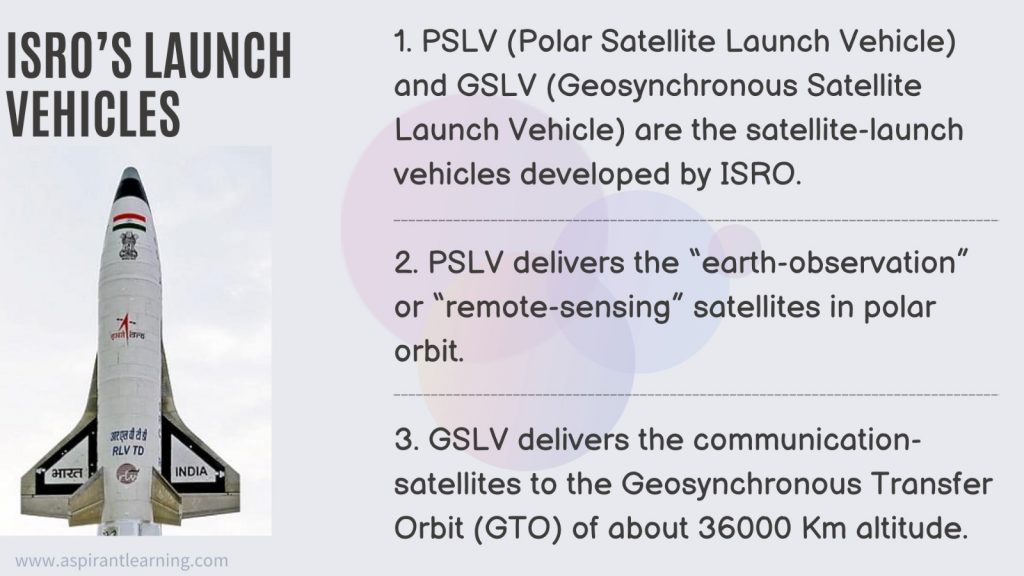News Highlights:
- Indian Space Research Organization (ISRO) is the nodal agency and flag bearer in the Indian Space Program.
- ISRO is the world’s sixth largest space agency that plays a vital role in the country’s development through the projects of defence, education, agricultural and educational sectors.
Indian Space Program:
- ISRO History:
- In 1962, Jawaharlal Nehru established the Indian National Committee for Space Research under the Department of Atomic Energy.
- Along with Jawaharlal Nehru, Dr Vikram Sarabhai, the eminent scientist of India, contributed significantly to the development of the INCOSPAR.
- TERLS, the Thumba Equatorial Rocket Launching Station used to launch rockets, was established by INCOSPAR at Thumba, near Thiruvananthapuram, at the southern tip of the country.
- In 1969, INCOSPAR was converted into the Indian Space Research Organisation, but the Department of Space was established in 1972 (Now, ISRO is a part of the Department of Science).
- Objectives:
- The objectives of the Indian Space Program are twofold:
- Space discovery and exploration through space missions.
- Promotion of research and education related to space science in the country. E.g. Tele-education in remote areas in India.
Major Achievements of ISRO:
- Communication Satellites:
- Indian National Satellite (INSAT) system, which began operations in 1983 with the commissioning of INSAT-1B, is one of the largest domestic communication satellite systems in the Asia-Pacific region, with nine operational communication satellites in Geostationary orbit launched by the Indian Space Research Organisation (ISRO).
- It ushered in a big transformation in India’s communications market, which it maintained later.
- Telecommunications, television transmission, satellite newsgathering, societal applications, weather forecasting, disaster warning, and Search and Rescue operations are all served by the INSAT system.
- Earth Observation Satellites:
- ISRO has launched several operational remote sensing satellites since IRS-1A in 1988. India now operates one of the world’s largest constellations of remote-sensing satellites.
- To provide necessary data in diversified temporal, spectral, and spatial resolutions, various instruments have been developed and flown onboard to serve different national and international purposes.
- The data collected by ISRO through these satellites are then used for various applications like disaster management, ocean resources, forestry, environment, mineral prospecting, rural development, urban planning, water resources, and agriculture.
- Navigation Satellites:
- To meet the Civil Aviation requirements, ISRO is working jointly with the Airport Authority of India (AAI) in establishing the GPS Aided Geo Augmented Navigation (GAGAN) system.
- To meet the user requirements of the positioning, navigation and timing services based on the indigenous system, ISRO is establishing a regional satellite navigation system called Indian Regional Navigation Satellite System (IRNSS).
- Experimental Satellites:
- ISRO has launched a range of small satellites, mostly for research purposes.
- This experiment includes remote sensing, atmospheric studies, payload creation, orbit controls, and recovery technology.
- Small Satellites:
- Within a short timeframe, the small satellite project will provide a forum for stand-alone payloads for earth imaging and science missions.
- Two types of buses, the Indian Mini Satellite -1 (IMS-1) and Indian Mini Satellite – 2 (IMS-2), have been designed by ISRO and built to provide a flexible platform for various payloads (IMS-2).
- Space Science & Exploration Satellites:
- Satellites come under this category: AstroSat, the first dedicated Indian astronomy mission to simultaneously study celestial sources in X-ray, optical and UV spectral bands.
- Mars Orbiter Mission (MOM), the genuinely maiden interplanetary mission of ISRO, launched on November 5, 2013. Chandrayaan-1, India’s first mission to the moon, and Chandrayaan-2, the second mission, comprised an Orbiter, Lander and Rover, etc.
- Academic Institute Satellites:
- ISRO’s operations, such as creating connectivity, remote sensing, and astronomy satellites, have affected educational institutions.
- The launch of Chandrayaan-1 piqued universities’ and institutions’ interest in developing experimental student satellites.
- Scramjet (Supersonic Combusting Ramjet) Engine:
- In August 2016, ISRO successfully conducted the Scramjet (Supersonic Combusting Ramjet) engine test.
- The Scramjet engine uses Hydrogen as fuel and Oxygen from the atmospheric air as the oxidiser.
- The new propulsion system will complement ISRO’s reusable launch vehicle with a longer flight duration.

Upcoming Milestones:
- Chandrayaan-3 Mission:
- ISRO will likely launch Chandrayaan-3 Mission in mid-2023 (earlier, it was the third quarter of 2022).
- Three Earth Observation Satellites (EOSs):
- Using the ISRO’s workhorse PSLV, EOS-4 (Risat-1A) and EOS-6 (Oceansat-3) will be launched.
- However, EOS-2 will be launched as SSLV (Small Satellite Launch Vehicle).
- Shukrayaan Mission:
- After successfully launching the Satellite to Mars, ISRO plans to launch a Satellite to Venus, tentatively named Shukrayaan.
- Own Space Station:
- Joining China, Russia, and the US in the league, ISRO is planning to launch its first space station by 2030.
- XpoSat: XpoSat, a Space observatory, is designed by ISRO to study the cosmic X-Rays.
- Aditya L1 Mission:
- The Indian Space Program has a mission to launch a satellite able to go 1.5 million km to Lagrangian between Earth and the Sun.
Challenges and Opportunities:
- Since India is a developing country, it is not in a state that faces certain security and development issues. For example, ISRO becomes questionable and has to justify the allocations for the missions that involve a lot of effort and do not have a direct bearing on development.
- A threat has been elevated by China after the testing of its ASAT, an Anti-satellite missile, in 2007. It can initiate an arms race in Space along with that on land.
- Because India relied on satellites like MOM, there have been military vulnerabilities.
- Though DRDO is developing a missile, it needs the US or other countries as its partners.
- The satellite was launched by China against Sri Lanka and Pakistan in 2011 and 2012.
- The government is more involved in discussing the code of conduct and other important documents with the US and the EU.
- There have been internal disputes in ISRO.
Pic Courtesy: Freepik
Content Source: The Hindu



